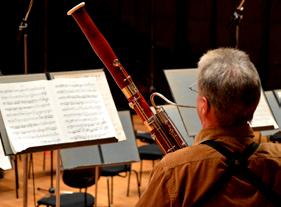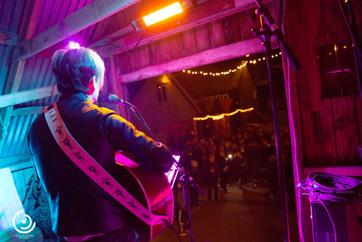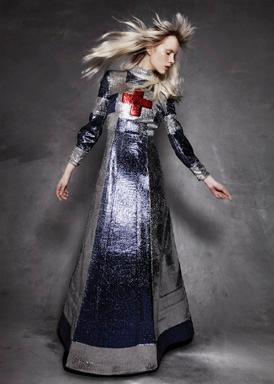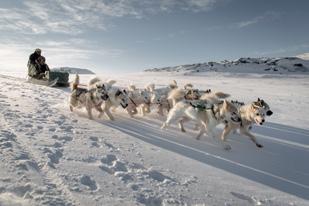
5 minute read
Happenings this autumn
EVENTS In Iceland and beyond Out and about
Looking for things to do as the weather starts to chill? Check out our top picks for the coming months.
TEXT: Sarah Dearne

PHOTO: Jez Tozer PHOTO: Sigmar Morkore PHOTO: Loubos Houska

Belfast, Northern Ireland 6–28 October Eidi, Faroe Islands 12–15 October Aberdeenshire, Scotland 26 October – 11 November
BELFAST INTERNATIONAL ARTS FESTIVAL As the weather cools and the drizzle sets in, Belfast lights up with three weeks of culture and colour. The BIAF brings world-class international performers and creators to the city while showcasing Northern Ireland’s very own best and brightest. This year’s highlights include the Mariinsky Orchestra, which will be performing an all-Russian programme; the brilliant Donny McCaslin Group, who were David Bowie’s last band, collaborating with him on Black Star; and Celui Qui Tombe (He Who Falls), a fusion of dance and acrobatics that plays out on a spinning, tilting stage. And if you see nothing else, don’t miss the iconic Weeping Window installation, a cascade of ceramic red poppies that will move even the stubbornest contemporary art sceptic. → www.belfastinternationalartsfestival.com
HEYSTFAGNADUR (AUTUMN FESTIVAL) Although the Faroes are known as a land of fishermen, it’s the scruffy native sheep that has their heart. A proud silver ram decorates their coat of arms, and the country’s name even derives from the Norse word for sheep – Foroyar, the Sheep Islands. This rich shepherding culture is celebrated at Heystfagnadur (Autumn Festival) in the village of Eidi. Harvest-themed events include a sheep market, butchering and sausage-making, followed by a downhome country ball with live music and carousing into the night. And if you’re not too stuffed with sausages to move, hike up to the nearby Eidiskollur cliff, which has astonishing views down to Risin og Kellingin (“the Giant and the Hag”), 70 m sea stacks with a curious folkloric past. → www.visitfaroeislands.com/ event/heystfagnadur
SOUND MUSIC FESTIVAL Sound is all about new music, showcasing an eclectic mix of contemporary classical and jazz compositions in addition to hands-on workshops and cross-media exhibitions. Its magic lies in its openness to experimentation, setting up a sonic sandbox where composers can play and collaborate, uninhibited by stuffy conventions. This year’s programme sets out in pursuit of a “northern sound”, with panels and performances exploring how the region’s landscape and languages seep into compositions, intentionally or otherwise. There’s also a special focus on the bassoon, the Barry White of the woodwind family. You’ll find intriguing events in concert halls, bars, and even lighthouses all over Aberdeenshire. → www.sound-scotland.co.uk
PHOTO: Alexander Matukhno
Reykjavik & Akureyri, Iceland 1–5 November in Reykjavik, 2–3 November in Akureyri

ICELAND AIRWAVES Now in its 18th year, Iceland Airwaves can no longer be contained by Reykjavik and is stretching its limbs up to Akureyri. The programme is set up so you can get passes for the four-day festival in Reykjavik, two days in Akureyri, or a combination of both. Make up your mind quickly though, as tickets sell out fast. But if you miss out, all is not lost – there are plenty of off-venue events to keep the party going. Flip over to page 26 to read more about Airwaves 2017. → www.icelandairwaves.com

PHOTO: Visit Mývatn

Myvatn, Iceland 1–24 December
YULE LADS AT DIMMUBORGIR Christmas in Iceland is a little bit different. Instead of the rosy-cheeked Coca-Cola Santa, we have 13 mischievous characters known as jolasveinarnir, the Yule Lads. Historically the Yule Lads were more interested in thieving than giving, and their names reflect their modus operandi: Pot Scraper, for example, steals leftovers, while Sausage Swiper makes off with strings of smoked wurst. In the 20th century they turned over a new leaf and began placing gifts in the shoes of well-behaved children. You can meet the Yule Lads and see how they prepare for Christmas at their home in Dimmuborgir, an enchanting lava field close to Lake Myvatn, a bit over an hour’s drive from Akureyri. → www.jolasveinarnir.net
PHOTO: Mads Pihl – Visit Greenland
Ilulissat, Greenland March–April
DOG SLEDDING Dog sledding is an exhilarating way to see the sights of the Arctic while bringing centuries of culture along for the ride. More than that, it remains a way of life in Greenland, holding its own against the rise of the snowmobile. Indeed, Greenland dogs have several advantages over their engine-run counterparts: they know the way, never run out of petrol, and they’re a heck of a lot cuter. Dog sledding season is from March to April, and one of the best places to go is Ilulissat, pop. 4,500 people, 3,500 dogs. Air Iceland Connect runs tours to Ilulissat, where you’ll also see (and hear) the enormous icebergs of the Ilulissat Icefjord and and have the opportunity to explore the colourful town. From there, you can take excursions to Eqi glacier (where you can stay overnight in a hut) and visit the nearby settlements of Oqaatsut/ Rodebay and Ilimanaq. → www.airicelandconnect.com/ tours/greenland
DID YOU KNOW...
The Arctic tern covers a distance of 35,000 km (21,748 mi) twice yearly between its winter habitat in Antarctica and its breeding territory in Iceland? The maximum range of the Bombardier Q400 is 2,841 km.
Facts and figures
Air Iceland Connect destinations at a glance
FAROE ISLANDS Capital: Torshavn (62°N) Population: 50,000 Size: 1,399 km2 (540 sq mi) Status: Autonomous constituent country within the Kingdom of Denmark Language: Faroese and Danish. English is also widely spoken.
GREENLAND Capital: Nuuk (64°N) Population: 56,000 Size: 2,166,086 km2 (836,330 sq mi) Status: Autonomous constituent country within the Kingdom of Denmark Language: Greenlandic. Danish and English are taught in school, though levels of fluency vary.
ICELAND Capital: Reykjavik (64°N) Population: 334,000 Size: 102,775 km2 (39,682 sq mi) Status: Independent republic Language: Icelandic. English is also widely spoken.
NORTHERN IRELAND Capital: Belfast (55°N) Population: 1,870,000 Size: 14,130 km2 (5,460 sq mi) Status: Country and a constituent unit of the United Kingdom Language: English. Irish and Ulster-Scots are also spoken in some areas.
SCOTLAND Capital: Edinburgh (56°N) Population: 5,730,000 Size: 77,933 km2 (30,090 sq mi) Status: Country and a constituent unit of the United Kingdom Language: English. Scots and Scottish Gaelic are also spoken in some areas.










